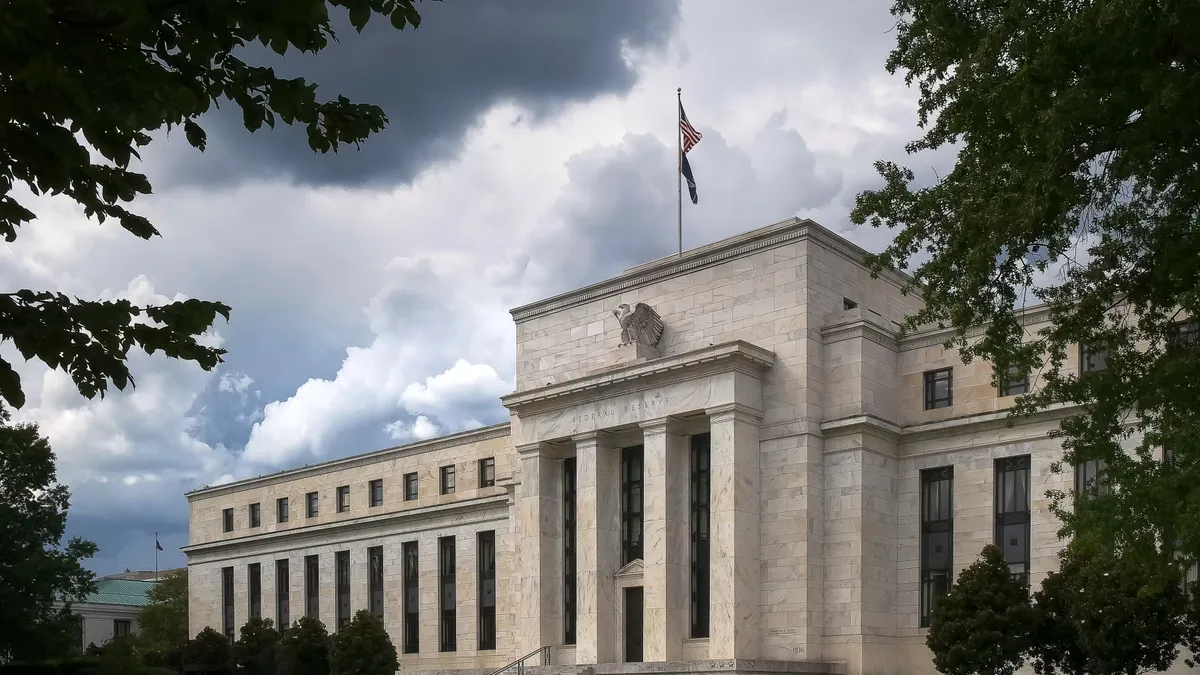Dive Brief:
- Federal Reserve officials last month supported raising the benchmark interest rate by either 50 or 75 basis points at their July 26-27 meeting, noting persistent supply chain bottlenecks and the need to ensure their credibility in fighting the highest inflation in four decades, according to minutes from a Federal Open Market Committee (FOMC) meeting.
- “Many participants judged that a significant risk now facing the committee was that elevated inflation could become entrenched if the public began to question the resolve of the committee to adjust the stance of policy as warranted,” according to the FOMC minutes released Wednesday.
- The FOMC during the June 14-15 meeting voted to raise the main interest rate by 75 basis points in the largest increase since 1994. Participants voiced concern “that inflation pressures had yet to show signs of abating, and a number of them saw it as solidifying the view that inflation would be more persistent than they had previously anticipated,” the minutes show. A basis point is one hundredth of a percentage point.
Dive Insight:
Policymakers including Fed Chair Jerome Powell have acknowledged that the central bank underestimated the persistence of supply chain constraints and should have begun reducing record stimulus earlier. At the meeting last month they believed tight supplies of goods across many industries continued to fuel inflation.
Participants “saw little evidence to date of a substantial improvement in supply constraints, and some of them judged that the economic effects of these constraints were likely to persist longer than they had previously anticipated,” the minutes show.
“In many industries, the ability of firms to meet demand continued to be limited by labor shortages and supply chain bottlenecks,” according to the minutes. “Firms relying on international sources for their inputs were seen as encountering particularly acute supply chain disruptions.”
Supply chain bottlenecks have recently shown some signs of unclogging. The ISM Manufacturing Inventories Index rose slightly in June, according to a report released Friday by the Institute for Supply Management (ISM).
The Global Supply Chain Pressure Index (GSCPI) declined in May. “The moves in the GSCPI over the past three months suggest, for now, a stabilization of global supply chain pressures at historically high levels,” according to the New York Fed, which created the index based on 27 metrics such as cross-border transportation costs.
“Measures of supply-chain stress have returned to recognizably normal ranges,” according to Ian Shepherdson, chief economist at Pantheon Macroeconomics. “Business surveys over the past few weeks, including Friday’s ISM manufacturing report, make it clear that supply constraints are easing across the economy.”
As the pandemic recedes, consumers have shifted their spending from goods to services, reducing the imbalance between supply and demand and prompting retailers such as Wal-Mart and Target to report bloated inventories.
“Retail inventory-to-sales ratios now are rising everywhere except autos, and in some components — notably, general merchandise — they are well above the pre-COVID trend,” Shepherdson said.
Fed Chair Jerome Powell has repeatedly raised the prospect that in coming months, as constraints on supply chains clear up and tighter monetary policy crimps demand, price pressures may fall as quickly as they surged beginning in October.
“As demand comes down, inflation could actually come down more quickly,” Powell said during a June 29 webcast hosted by the European Central Bank.
Prices of autos soared during the pandemic as a shortage of semiconductors and other essential parts thwarted efforts by manufacturers to keep up with rising demand, Powell noted. In the coming months “it could be different because it’s just this process working in reverse.”
Price pressures show no sign of easing sufficiently to satisfy policymakers.
The Fed’s preferred measure of inflation — the core personal consumption expenditures price index — increased 4.7% in the year through May, slowing from 5.3% in February, according to the Labor Department. When changes in food and energy prices are included, the index rose 6.3%.
The consumer price index rose in May more than many economists expected, surging 8.6% year-over-year in the biggest jump since December 1981.












